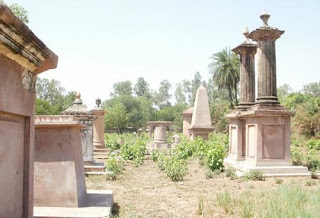 |
| European cemetery Ambala Cantonment www.visitin.in |
 |
| European cemetery Ambala Cantonment astrolika.com/ |
 |
| Christian cemeytery, Ambala, Haryana. tourmet.com/ |
spreads across 23 acres. It is believed to be the biggest burial ground in the northern region with more than 2 lakh. “The discovery of the cemetery is significant as some British soldiers and even prisoners from the Second Anglo-Boer War are buried there,” said an officer Madhav Acharya.
Many of the graves were built in European style with cubic and rectangular domes over the burial ground. The entrance of this grave has two large cylindrical pillars with triangular dome on it. There are also obelisk structures and it is said, they were meant for the higher officials served for British India. A simple cement structure with a cross is seen in the graves of prisoners of war (POWS) and soldiers. The entrance of this grave is built with two large cylindrical pillars with triangular dome on it. The graves here are the war heroes of Africa, British soldier's prisoners of war and its company officials. It is located in the Cantonment Area, Jagadhri Road, Ambala City. There are 20 boer graves here.
It is observed that most of the grave blocks here are made of granite stones, clay bricks, sand stones and few are placed with marble stones. Cross made of cement and jelly stones are found in the burial place of the common people. The marble stone plaque has encryption of the blessed souls who were buried here. St Paul's Church of Roman Catholic order, takes care of the rituals associated with the blessed ones.
 |
| Location map Ambala, Haryana. jatland wiki |
the great Anglo Boer War of 1880 -1881 AD and 1899 to 1902 AD fought in the South African countries. The war broke out between the British Empire and Bore Farmers who had been living there for a long time. Lots of British soldiers were killed in these wars and the British captured the revolting rebels in large numbers and sent them to colonies like Sri Lanka, India, etc. Lots of rebels from Africa were imprisoned in Ambala, and later executed and buried in the graveyard. Similarly many Boer farmers and Africans who were unable to return home were buried here.
During the Independence time, one British officer came to Ambala to pay homage to the great 'British War heroes' of Anglo Boer War. Then only the Indian media and others came to know of the presence of a European graveyard here that included Boer farmers of Africa. After Independence, the Roman catholic church took care of the rituals and now manages it with the ASI.
This grave is a reminder of memories of Anglo Bore War held fought in South Africa. This place comes under Large Grave category of European Colonial Era in the tourist chart of Haryana tourism. Yet another historical importance is the grave is the final resting place of the last EIC and their families. https://www.astrolika.com/monuments/european-cemetery-ambala.html
https://www.telegraphindia.com/india/boer-graves-in-ambala/cid/716559







.webp)

